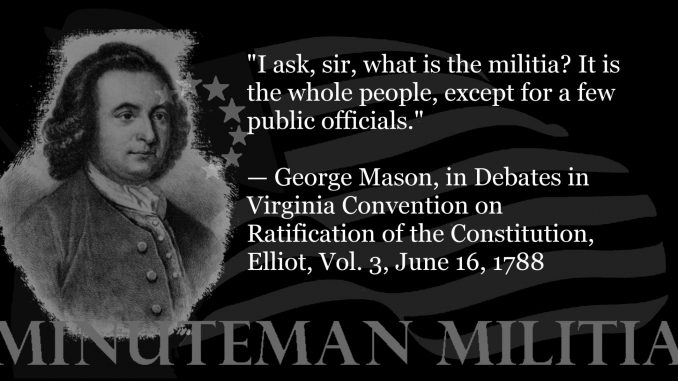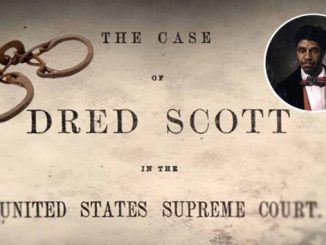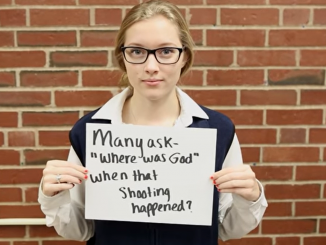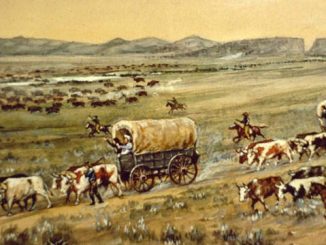
Components of the Militia
When asked what the Militia was, George Mason, one of the Framers of the U.S. Constitution, said, “Who are the Militia? They consist now of the whole people, except for a few public officers.” Yet we also see statutes like 10 USC 311, which defines it as “all able- bodied males at least 17 years of age and, except as provided in section 13 of title 32, under 45 years of age who are, or have made a declaration of intention to become, citizens of the United States.” Some state statutes define it as “able-bodied males” of different age ranges, such as 16 through 59.
These statutes also divide the Militia into various classes, such as “organized” or “unorganized”, in the case of 10 USC 311, or “active” and “reserve”, as many states do, with “active” being considered the National or State Guards, but not the national armed forces.
To understand how these definitions have arisen, one must first understand what the Framers of the U.S. Constitution had in mind for the new Republic they had created. They allowed for a standing national army, but insisted that it be kept small, and although it might be the first force to be called out, and the only force to be sent abroad, the primary defense of the country was to be the duty of ordinary citizens, who would be kept in a state of military readiness while leading their normal lives, and who would be called up to “repel invasions, suppress insurrections, or execute the laws”, for limited periods of time. At the time the Constitution was adopted in 1789, the well-established tradition was for local militia units to be kept in a state of readiness in each and every community. Such units were organized and trained locally, perhaps led by the local town or county officials, but otherwise independent of official control when not actually called up for service.
When lawmakers tried to define the “militia” by statute to consist of less than the entire body of citizens, they were defining those citizens who would be required to be kept in a state of readiness, as was done in the Militia Act of 1792, which required able-bodied males age 17 through 44 to keep a “musket or firelock”. However, persons younger than 18 and older than 45 regularly responded to call-ups of the Militia and were accepted as part of it. There were even some women who participated.
The Framers also insisted on a distinction between the “genuine” Militia and a “select” militia, which they viewed as a danger, just as much a danger as a standing army. They did not want a militia whose members might consist of anything less than the entire people, or at least able-bodied ones in a certain age range, because if selected on any other basis, they might be used to oppress other parts of the population.
Actually, George Mason provided the best definition. It only needs to be broken out into various classes, representing the order in which persons would be called out for military service. Qualifications like “able-bodied” or “male” or “age 18-44” only establish who would be first called to service, with the expectation that they would be adequate for almost any situation, but it allows for calling up other persons if needed.
This suggests a hierarchy of classes:
National Army.
Full-time. Army, Navy, Air Force, Marines, Coast Guard.
Part-time. Reserves, National Guard.
State and Local Select Militia. But these are not “general” militias. They are paid and equipped by the State or by local governments.
Full-time. State and local law enforcement officers.
Part-time. State Guard.
Obligatory Militia. Able-bodied male citizens of a certain age range, who are required to be kept organized and trained, but at their own expense. Age range is 18-44 for federal purposes, but states may establish other age ranges.
Volunteer Militia. Citizens not part of obligatory militia who voluntarily participate in activities of the obligatory militia, again at their own expense.
Ready Militia. The combination of (3) and (4) above, who would be called up after the armed forces and the regular militia, but who are also those likely to be first on the scene in emergency situations. It is not a “select” militia.
Reserve Militia. All other citizens, including children, the elderly, the less-able, and women, and perhaps foreign visitors as well, who might be called up after the ready militia, if needed.
What is missing from the current picture is the ready militia.

Most states now lump it in with what we are here calling the reserve militia, and in fact often call it that. The ready militia is what the Framers meant when they used the term “militia”. It is also what the Swiss mean by the term, and it was the Swiss model that the Framers had in mind for the United States. The ready militia was to serve as a counterbalance to the armed forces and regular state (select) militias.
[adrotate group=”5″]
It should be noted that the obligatory militia is usually defined to exempt certain public officials, and perhaps persons with certain occupations, whose usual duties are considered essential.
Choice of words can be indicative. 10 USC 311 lumps the ready and reserve militias into what it calls the “unorganized” militia, with the implication that it is to remain unorganized, since no provisions for organizing and training the ready militia are given, contrary to the intent of the Framers.
Militias are local and independent
 Often heard are arguments about whether militias are state or national, but the militia, like citizenship, is fundamentally local. We are first and foremost citizens of our local community. The word “citizen” has the same root as the word “city”. Although people may also be concurrently citizens of larger political entities, such as states or the nation, and although those entities may be considered to be composed of their citizens, they are essentially composed of localities, and it is the local community that is the basis for the social contract, although it may be considered to include a certain amount of surrounding territory. Today we would usually identify the locality with the county.
Often heard are arguments about whether militias are state or national, but the militia, like citizenship, is fundamentally local. We are first and foremost citizens of our local community. The word “citizen” has the same root as the word “city”. Although people may also be concurrently citizens of larger political entities, such as states or the nation, and although those entities may be considered to be composed of their citizens, they are essentially composed of localities, and it is the local community that is the basis for the social contract, although it may be considered to include a certain amount of surrounding territory. Today we would usually identify the locality with the county.
[adrotate group=”5″]
Just as militias are essentially local, so also are they essentially independent of established authorities, since the militia may have to challenge or bypass those authorities if they abuse their authority or fail to perform their lawful duties.
The legal basis for assemblies of militias are two natural rights: the right to assemble and the right to keep and bear arms. Combined, they are the right to assemble bearing arms. The Framers considered it obvious that rights which could be exercised separately could be exercised in combination, and would have thought present attempts to outlaw independent assemblies of militia units as absurd. The term “well-regulated” used in the Second Amendment to the U.S. Constitution did not mean “regulated by some official”. It meant “well-trained and disciplined”. A militia can and should be self-regulated.
The U.S. Constitution, in Article I Section 8, does provide for States to organize and train their militias according to standards established by the U.S. Congress, and to appoint the officers, but it was not the intention of that clause to authorize states to forbid local organization and training of militia units, but to require that they be organized and trained. If the state fails to do so, people have not only the right but the duty to organize and train themselves locally, using their own arms. Just as they have the right and duty, failing action on the state level, to conduct elections, enforce the laws, establish courts, and so forth.
Of course, a militia unit that is not called up by any official, but by its own members, does not have the authority to compel participation through some kind of sanction, such as the imposition of a fine. Therefore it will be composed of volunteers, who may not represent a cross-section of the general population. In this situation, the militia members must make a special effort to avoid having the militia unit take on the attributes of a private association, such as by always calling up the militia using public notices, and allowing any responsible citizen to participate. It must also avoid any suggestion of partisan or sectarian bias, and limit itself to constitutional actions.
To do this, a militia unit should always refer to itself as the “[state/county] militia” and not adopt a name that would suggest some kind of private association, something that would expose its members to legal action against it as a legal “person” or as a “conspiracy”. There can’t be a conspiracy of the entire population of an area, and a court can’t serve the entire population with process, even if not all of them are present at meetings.

[adrotate group=”5″]
Organizing strategy
Militia units of 50-200 members should be organized at the local level, by going house by house, covering entire neighborhoods, towns, and counties.
This will initially be easier to do in rural areas, where people are already more receptive to the patriotic message. In urban areas, it may work better to start by organizing “neighborhood associations”, then educating the members gradually until it can be converted into a self-conscious militia unit.
Co-ordination among local units should be done using correspondence committees, which is the traditional method. These committees do not attempt to act as regional,, state, or national organizations, but only to facilitate communications among local units, the sharing of literature, and the building of a consensus for action.
Some units might try to publish newsletters or other documents, but in most cases, it will be better to publish through established magazines and various alternative media, and distribute extra copies. Members may agree to subscribe to media that co-operate in publishing supporting materials.
Dealing with official resistance
 For some time now the Establishment has discouraged the formation of armed groups, including independent constitutional militias. They don’t want the “unorganized” militia to become organized. Besides legal and illegal harassment, militia leaders must prepare participants to deal with attempts to infiltrate militia units. This can take three main forms:
For some time now the Establishment has discouraged the formation of armed groups, including independent constitutional militias. They don’t want the “unorganized” militia to become organized. Besides legal and illegal harassment, militia leaders must prepare participants to deal with attempts to infiltrate militia units. This can take three main forms:
Moles. Agents who pretend to be trustworthy but who are mainly focused on obtaining information about militia members and their activities.
Provocators. Agents who pretend to be responsible members, then, when least expected, do something which seeks to discredit the militia and perhaps provoke official action against it.
Dissipators. Agents who pretend commitment until they can assume positions of influence within the group, then use it to divert them into ineffective or unproductive activities, such as endless debate, socializing, and divisive disputes, or to reduce morale and resolve.
The best protection against infiltration is to teach members to be vigilant to it and to have a large number of small units and many leaders, none of whom is critical. There should be little or no leadership on the state or national level, other than a network of correspondence committees that facilitate communications.
It is also important to try to establish good relations with local and state officials, to the extent possible. Work with them to help them solve the problems of the community, and encourage them to ask the militia to assist them. Resistance from such officials should be countered by getting better ones elected or appointed.
[adrotate group=”5″]
Subjects for action
One of the most important subjects for action by local militia units is investigation of election fraud and other kinds of official corruption. It will do little good to try to elect better officials if elections are rigged, and if they are, the militia may become the only way for citizens to secure their rights. If such fraud is found, it will also help to build public support for further militia action and for greater participation.
Another key subject is to inform citizens of their right and duty, when serving as jurors in cases in which the government is a party, to judge the law and not just the facts in the case. No matter how despicable the defendant in a criminal case or how heinous the offense, the jury must find the defendant not guilty if the law under which he is charged is unconstitutional or misapplied. It is unconstitutional if it violates a constitutional right, is not based on a power delegated to government, or is so vague that honest people may disagree on how to obey or enforce it. It is misapplied if it is applied to acts outside its proper jurisdiction, such as a federal criminal law applied to acts committed on state territory, or to acts not intended to be included by the lawmakers.
One of the most important subjects for action will be to establish an alert system for warning of abuses of citizens by organs of the government, and mobilizing to defend them. It must be emphasized that it is not enough for citizens to defend their rights in isolation. Only if they band together can their rights be protected.
Education in constitutional law must also be a priority. Every citizen must be trained to interpret the constitutionality of laws and official acts, and taught that doing so is the responsibility of each individual, that it cannot be delegated to others, such as judges or superiors. That is the Lesson of Nuremberg. Special attention needs to be given to educating lawyers, judges, officials, and college and high school students. Militia members need to make sure that every public library contains suitable books and magazines that provide education on these subjects.
Copyright (C) 1994 Constitution Society. Permission is hereby granted to copy with attribution for noncommercial purposes.
References:
Morgan Norval, ed., The Militia in 20th Century America: A Symposium, 1985, available from Gun Owners Foundation, 5881 Leesburg Pike, Falls Church, VA 22041.
Stephen P. Halbrook, That Every Man Be Armed, 1984, available from the Independent Institute, 134 98th Ave, Oakland, CA 94603.
James M. & Kenneth F. Collier, Votescam: The Stealing of America, 1992, available from Victoria House Press, 67 Wall St #2411, New York, NY 10005.






WOW! I READ THE WHOLE DESCRIPTION OF WHAT THE MINUTEMAN MILITIA IS AND WHAT IT DOES AND DOESN’T DO. HOW CAN I BECOME ONE? I CAN BE ASKED ANY QUESTION. TO START, I AM A RETIRED ARMY SGM WITH 32 YEARS OF SERVICE AND A VIETNAM SURVIVOR.
This is true representation of our America. I prefer your site to get the truth of what is happening in our country. I tried watching through my facebook, but something weird going on with a breakdown in running smoothly. I decided to try on my laptop to see if there would be no problem. I admire what is represented here. We need strong support of our Constitutional rights, in these terrible times. God Bless America